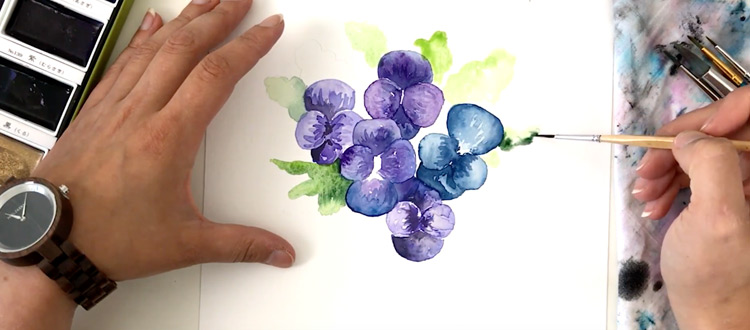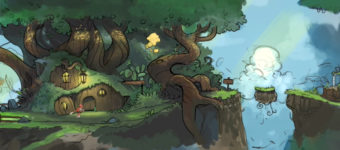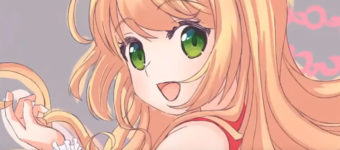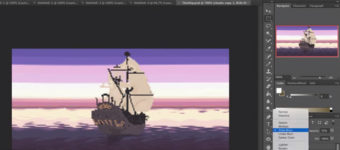40+ Free Watercolor Painting Video Tutorials For Beginners
Watercolors make a lot of artists nervous at first blush.
This isn’t the most forgiving medium since you can’t really erase or cover up mistakes.
Watercolor follows different rules than most other mediums. But once you learn these rules you might quickly fall in love with watercolors.
Despite their reputation as the problem child of wet media, watercolors are a ton of fun to learn with the right resources. We’ve found over 40 simple videos to help you become a whiz at watercolors in no time, and we’ve even divided them up into categories so you can quickly find what you need for your goals and skill level.
Getting Started/Basic Techniques & Supplies
4 Essential Watercolor Skills Every Beginner Must Know
There’s no better place to start than at the beginning, right?
This video covering four basic skills will help you learn how watercolor works and serve as a firm foundation for all the other skills you’ll learn from these tutorials.
This is the perfect place to start is you’re a complete beginner. By the end of this tutorial you’ll already have learned how to work with the translucency of watercolor so you can make your paintings pop!
Do’s & Don’ts for Beginners
Learning what NOT to do is just as important as learning what you should do!
Try these tips for preventing a lot of common problems watercolorists run into like flimsy paper, uneven color coverage, and pencil outlines that show through the paint.
How To Use Watercolor – Intro Tutorial
This simple tutorial will help you select the right supplies and get you familiar with basic watercolor techniques, all in under seven minutes.
This is the perfect video for getting a general idea of how watercolors work in record time.
7 Watercolor Tips (For Beginners!)
This video answers common beginner questions you didn’t even know you had.
Learn to create smooth color coverage rather than blotchy, messy color where every stroke is visible.
Also learn the difference between hot press and cold press paper(yes, that’s a thing) and how to properly store brushes so you aren’t running to the store every other day.
Watercolor brushes ain’t cheap!
Beginner’s Tutorial
Ready to graduate to a more detailed tutorial?
This video is still awesome for beginners but goes into more specifics about supplies and how to use them.
Learn about the different types of watercolor papers and the distinctions between paints that come in tubes and the ones that come in cakes. This video also explores possibilities with gouache which is another translucent paint similar to watercolor.
Watercolor Basics for Beginners
This is a fairly detailed tutorial on different watercolor techniques for painting with smooth coverage, using water to paint ratios to vary your color intensity, and controlling your paints so that they don’t run everywhere.
Yes, it’s got a lot.
This also showcases the playful, more forgiving side of watercolors so you can learn to loosen up and really play with the medium.
The Watercolor Color Wheel
If you’ve ever taken an art class you’ve probably seen or even made a color wheel.
Quick refresher: A color wheel is a diagram of the color spectrum, and creating a color wheel is an exercise in using the three primary colors(red, yellow, and blue) to mix each color of the rainbow.
This video shows you how to set up a color wheel and mix twelve different colors with watercolors.
Because watercolors behave differently than oil or acrylic paints, learning to mix colors without them getting muddy is essential.
Building on Techniques
How to Paint Intense Shadow Colors
Beginning watercolorists tend to run into issues when painting shadows.
This is because it’s easy to use too much water and paint too lightly, and also because selecting colors for shadows that pop instead of looking muddy can be a real challenge.
Try this tutorial for choosing colors and painting intense shadows that still look vibrant.
Blend Watercolor Paint Wet on Dry
Another common issue for beginners is blending smoothly instead of getting blotches of colors with hard edges, especially on dry paper.
Hard edges can be neat and all. But sometimes you just want a flawless, smooth color change.
Well this video does a great job of showing how to create smooth color gradients and blend colors together on the page, even if they’re already dry!
Watercolor Glazing and Layering Basics
Glazing and layering are great techniques for shading, smooth color changes, and creating values in your watercolor paintings while maintaining a high level of control.
Try this video to get started in all of these basic techniques.
You’ll be surprised how quickly you pick it up in your own work!
How to Paint Flat Washes
Painting a wash is one of the most basic skills you can develop when you’re just getting started with watercolors. And it’s surprisingly tricky to master.
Many beginners struggle with splotchy, pooling colors or washes that are over-watered and way too light.
If you struggle with this yourself try this video for some tricks to painting nice, smooth washes.
How to Paint a Graded Wash in Watercolors
After you’ve learned to paint perfect flat washes the next step is painting graded washes in one color, or washes with a color gradient.
This video will help you get splotch-free, smooth washes that lighten gradually over time.
A true watercolor painter’s best guide.
Lifting & Removing Watercolor Pigment
A common misconception about watercolors, and something that scares a lot of people away, is that you can’t erase.
Once the color’s on the page it’s there to stay. Right?
Well…maybe not.
Watch this video to learn how to lift watercolors from the page, either to create texture or value, or to fix a whoopsie you aren’t happy with.
How to Use Watercolor: Controlling the Water
In this awesome tutorial you’ll learn the secret to controlling your watercolors, which is controlling the water.
After all, the paint can only go where the water goes. Give this video a watch to learn how to use the water to your advantage so you can control it and not the other way around!
Splattering Technique by Tim Wilmot
Paint splattering might sound pretty self-explanatory (and like tons of fun!)
But it’s actually a legitimate technique that can really add some beautiful texture to your paintings. If you want to get started with splattering check out this tutorial on how and when to employ this technique for the greatest effect in your paintings.
Line and Wash Demonstration
Try out the classic combination of ink and watercolor with this demonstration.
You’ll love the unique textures and scratchy, illustrative effects of these two mediums together.
Pen and watercolor is an awesome combination for rendering details and little snapshots of life. The watercolor brings in a lovely spread of color while the pen is great for adding sharp, tight details and textures. The result is a gorgeous combo of a technical pen drawing and a loose watercolor painting.
Also this is the perfect opportunity to practice your light washes!
Painting Light Foliage Over Dark Backgrounds
One of the biggest rules of watercolors is to paint dark over light, because due to the translucency of watercolor you can’t paint a light color over a dark one.
So how the heck are you supposed to paint something light, like a yellow bush, over something dark, like a night sky?
This video tut will show you the trick to painting light foliage that looks like it’s actually in front of a dark background.
Hint: the secret is a handy little substance called masking fluid.
Painting People
How To Color Skin
Ready for something a little more challenging?
Well this tutorial shows you not only how to mix gorgeous skin tones(which is tough with ANY medium) but also how to create soft, smooth skin texture.
You’ll learn how to paint shadows and highlights that pop in any piece.
These techniques are perfect for any style of portrait, whether you’re going for photorealism or cartooning or something more.
How To Paint Faces With Watercolor
If you already have a decent grip on drawing faces and want to start painting them in watercolor, this tutorial will show you how to paint those beautiful vibrant skin tones using layering techniques.
Take a look at this tutorial because it demonstrates how to use pooling and hard edges to your advantage.
When done right this can create stunning, surreal faces and hair that really pop off the page.
Up-Close & Detailed Still Life
The still life is another classic ambition for a painter in any medium.
This is another long one but this demonstration is worth the watch to see how an expert watercolor painter renders detail, shadow, light, and form.
This is one of those situations where you can learn just as much from watching as you can from actually doing.
How to Paint Hair and Ears
If you’re planning to paint watercolor portraits then chances are you’re going to be running into hair and ears at some point.
If you have the patience to practice these subjects have a peek at this video. It shows you how to use masking fluid to paint smooth ears that look three-dimensional and perfect hair with beautiful depth and movement.
How to Paint a Realistic Mouth
If you’re interested in painting portraits make sure to watch this tutorial on painting realistic female lips.
Lips are surprisingly finicky and a huge sticking point for a lot of budding portrait artists.
This is also great practice in mixing skin tones too!
You can never have too much practice mixing tones, right?
Plants & Animals
Watercolor Whale in 7 Easy Steps
Now that you’ve mastered some basic techniques let’s get started with some projects!
Try this approachable tutorial for painting a simple, whimsical whale in watercolors.
This is your chance to really have fun and experiment with watercolor to create some pieces you’re truly proud of.
A Cactus with Watercolors
When you’re feeling a little more confident with watercolors you might check out this demonstration of an easy cactus painting. And you might even try recreating it for yourself.
Even if you don’t feel like a pro yet, make sure to give this a watch.
It’s always helpful to see how someone else’s painting comes together so you can observe how the process works.
Dancing Jellyfish
This video uses both dry and wet on wet techniques to create a trio of loose, painterly jellyfish.
The artist also includes captions that explain the techniques and colors she’s using so you can try recreating this practice piece on your own.
A Simple Tree (Subtitles)
Oh trees.
So beautiful, but such a difficult subject to paint.
Trees are made up of tons of tiny leaves and cracks in bark which makes them one of the hardest subjects for any artist, beginning watercolorists included.
Watch this video to learn how to paint a tree that pops off the page rather than looking like a flat blob. This technique works without having to paint each individual leaf and detail in the bark.
Watercolor Leaves + Wreaths
As we learned from the tree video above: leaves look stunning in watercolors!
This video will show you different techniques for painting all kinds of leaves and then combining them into a stylized watercolor wreath.
You can use this in personal stationary or as a fun frame for lettering. Or anything else you might enjoy.
How To Paint a Watermelon
As it turns out, watercolor is the perfect medium for rendering a fruit that is mostly water. Funny how that works, right?
Step one: Watch this fun tutorial on how to paint an adorable watermelon.
Step two: Paint yourself a watermelon.
Step 3: Eat a watermelon. Easy!
Yellow Rose(Multipart)
If you’re feeling confident and in the mood for a challenge try this detailed tutorial on painting a realistic yellow rose.
This piece combines a lot of the techniques you’ve already learned so it’s a great opportunity to practice your color mixing, blending, lifting, and water control.
Draw & Paint Bell Peppers
No matter how you feel about bell peppers, you can’t deny that they’re a great painting subject.
With their vivid colors, smooth form, and shiny surface, who wouldn’t love them?
Check out this tutorial on sketching and painting a lovely pair of bell peppers. Whether you choose to eat your peppers afterwards is up to you!
Land, Sea, and Cityscapes
Scene in Venice
When artists first pick up watercolor painting, we often picture ourselves painting wonderful landscapes or cityscapes in our travel sketchbooks while away on vacation.
But when we actually try to do it we get overwhelmed with all that detail.
If you’ve got an hour and want to get into landscapes watch this tutorial on how to simplify what you see in a scene.
That way you can capture the important things on the page without driving yourself crazy painting every brick and blade of grass.
Pond Scene
Water is another interesting subject because it involves a lot of reflection. And this has more colors than you might think!
In this video you’ll learn how to paint a quick, simple mountain pond scene that conveys the essence of the water and surrounding landscape.
Again, the trick to painting landscapes is to simplify, simplify, simplify.
And this tutorial shows you how to do it very well.
Plein Air Tutorial
One of the best things about watercolors is that they’re surprisingly portable.
So you may want to get out there and paint in the open, but you might feel a bit self-conscious.
Well check out this video to get an idea of how to quickly paint a beautiful mini landscape on the go. No drawing required.
Pro-tip: for more portable watercolor painting you might want to pick up a waterbrush, a handy brush tool that holds water in the handle so you don’t have to carry a separate water container. Neat, right?
Sunny Geranium Window Box
One of the best ways to learn a new watercolor skill is to watch other people who know what they’re doing.
Enjoy this quick demo of a flowery window box painting to pick up some new tips if you’re stretched for time.
It’s a great video and there’s a lot to learn if you pay attention.
Icy Winter Landscape
Winter landscapes are an awesome subject for watercolors because the translucency works really well for rendering cloudy skies and shadows on snow.
If you’re a winter lover then this tutorial on painting a winter wonderland will grab your attention. It teaches watercolor painting with loose, wet on wet techniques and only three colors.
This video also introduces a fun texturing tool you probably have around your house: a cut-up credit card!
Paint a Country Mailbox
This fancy tutorial will give you some fun practice with shading light-colored subjects and with a match made in art heaven: ink pen and watercolor.
Watercolor provides the form, color, and shadow, and pen adds the details. It’s the perfect combo!
While this demo doesn’t provide verbal instructions, it does list the colors used by the artist and if you’ve mastered the basics, the techniques are pretty easy to follow.
Realistic Rocks Step-By-Step
Yeah, rocks can be surprisingly tough to paint.
Artists tend to feel one of two ways about rendering rocks: Either they think they’re really hard to paint or they don’t think about them much until they actually try to paint them.
Here’s a great tutorial on how to paint 3D looking rocks with striking shadows and highlights. No more shapeless gray blobs!
Basic Landscape Painting
Watercolor landscapes are classic for a reason! This gorgeous video demonstrates the painting of a vibrant panoramic landscape in full view.
It helps if you already have some experience to follow along but I think anyone could pick this up and move with it.
You’ll be painting your own amazing landscapes in no time!
Note: if you haven’t tried this elongated shape for your paintings and drawings yet, give it a try! It might become your new go-to for landscape paintings.
Rough Ocean Water
Seascapes are the twin sister of landscapes. And this video shows you how to paint detailed ocean waves with beautiful, deep colors and highlights that really pop.
Seascapes might be your new favorite thing to paint once you’ve tried.
Italian Vista Watercolor
If you’ve got some more time on your hands then settle in and enjoy this demonstration of a vibrant mountain lake painting with tube colors.
This is a recording of a live video with live questions, so make sure to watch the whole thing to learn the most from it.
You might get answers to some questions you didn’t even think to ask.
How To Paint a Rural Scene
Lastly in this video you’ll find a variety of common watercolor techniques for creating a lovely painting of a country road. Follow along or just watch and learn!
You can’t go wrong either way and this’ll really ignite your passion for painting.
Yes, watercolors can feel finicky and difficult at first. But they’re a surprisingly forgiving and versatile medium.
No other medium has quite the same light, ethereal quality to it.
Watercolors can be tight and technical, loose and playful, or any combination of the two.
As an added bonus, learning to control the translucency is a great brain workout that will build skills that transfer to many other mediums. If you haven’t tried out watercolors yet then grab some supplies, pull up these videos, and give them a shot!













